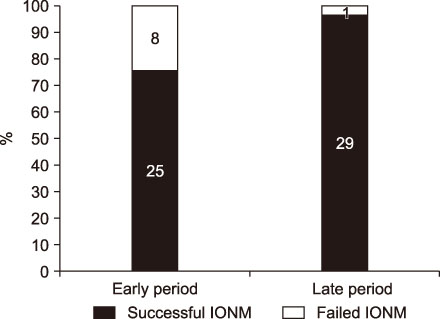Int J Thyroidol.
2018 Nov;11(2):130-136. 10.11106/ijt.2018.11.2.130.
Efficacy of Intraoperative Neural Monitoring (IONM) in Thyroid Surgery: the Learning Curve
- Affiliations
-
- 1Department of Otorhinolaryngology-Head and Neck Surgery, Hanyang University College of Medicine, Seoul, Korea. kytae@hanyang.ac.kr
- KMID: 2448983
- DOI: http://doi.org/10.11106/ijt.2018.11.2.130
Abstract
- BACKGROUND AND OBJECTIVES
Intraoperative neural monitoring (IONM) of recurrent laryngeal nerve (RLN) in thyroid surgery has been employed worldwide to identify and preserve the nerve as an adjunct to visual identification. The aims of this study was to evaluate the efficacy of IONM and difficulties in the learning curve.
MATERIALS AND METHODS
We studied 63 patients who underwent thyroidectomy with IONM during last 2 years. The standard IONM procedure was performed using NIM 3.0 or C2 Nerve Monitoring System. Patients were divided into two chronological groups based on the success rate of IONM (33 cases in the early period and 30 cases in the late period), and the outcomes were compared between the two groups.
RESULTS
Of 63 patients, 32 underwent total thyroidectomy and 31 thyroid lobectomy. Failure of IONM occurred in 9 cases: 8 cases in the early period and 1 case in the late period. Loss of signal occurred in 8 nerves of 82 nerves at risk. The positive predictive value increased from 16.7% in the early period to 50% in the late period. The mean amplitude of the late period was higher than that of the early period (p < 0.001).
CONCLUSION
IONM in thyroid surgery is effective to preserve the RLN and to predict postoperative nerve function. However, failure of IONM and high false positive rate can occur in the learning curve, and the learning curve was about 30 cases based on the results of this study.
Keyword
MeSH Terms
Figure
Reference
-
1. Jung KW, Won YJ, Oh CM, Kong HJ, Lee DH, Lee KH, et al. Cancer statistics in Korea: incidence, mortality, survival, and prevalence in 2014. Cancer Res Treat. 2017; 49(2):292–305.
Article2. Kern KA. Medicolegal analysis of errors in diagnosis and treatment of surgical endocrine disease. Surgery. 1993; 114(6):1167–1173. discussion 73-4.3. Kim SW, Kim JW, Park JH, Oh CH, Jang HS, Koh YW, et al. Efficiency of intraoperative recurrent laryngeal nerve monitoring using electromyography tube in reoperative thyroid surgery. Korean J Otorhinolaryngol-Head Neck Surg. 2012; 55(4):229–233.
Article4. Randolph GW, Dralle H; International Intraoperative Monitoring Study Group, Abdullah H, Barczynski M, Bellantone R, et al. Electrophysiologic recurrent laryngeal nerve monitoring during thyroid and parathyroid surgery: international standards guideline statement. Laryngoscope. 2011; 121:Suppl 1. S1–S16.
Article5. Timmermann W, Hamelmann WH, Thomusch O, Sekulla C, Grond S, Neumann HJ, et al. Effectiveness and results of intraoperative neuromonitoring in thyroid surgery. Statement of the Interdisciplinary Study Group on Intraoperative Neuromonitoring of Thyroid Surgery. Chirurg. 2004; 75(9):916–922.
Article6. Shedd DP, Burget GC. Identification of the recurrent laryngeal nerve. Arch Surg. 1966; 92(6):861–864.
Article7. Zheng S, Xu Z, Wei Y, Zeng M, He J. Effect of intraoperative neuromonitoring on recurrent laryngeal nerve palsy rates after thyroid surgery--a meta-analysis. J Formos Med Assoc. 2013; 112(8):463–472.
Article8. Yang S, Zhou L, Lu Z, Ma B, Ji Q, Wang Y. Systematic review with meta-analysis of intraoperative neuromonitoring during thyroidectomy. Int J Surg. 2017; 39:104–113.
Article9. Wong KP, Mak KL, Wong CK, Lang BH. Systematic review and meta-analysis on intra-operative neuro-monitoring in high-risk thyroidectomy. Int J Surg. 2017; 38:21–30.
Article10. Pisanu A, Porceddu G, Podda M, Cois A, Uccheddu A. Systematic review with meta-analysis of studies comparing intraoperative neuromonitoring of recurrent laryngeal nerves versus visualization alone during thyroidectomy. J Surg Res. 2014; 188(1):152–161.
Article11. Dralle H, Sekulla C, Lorenz K, Brauckhoff M, Machens A, German ISG. Intraoperative monitoring of the recurrent laryngeal nerve in thyroid surgery. World J Surg. 2008; 32(7):1358–1366.
Article12. Barczynski M, Konturek A, Cichon S. Randomized clinical trial of visualization versus neuromonitoring of recurrent laryngeal nerves during thyroidectomy. Br J Surg. 2009; 96(3):240–246.
Article13. Dionigi G, Wu CW, Lombardi D, Accorona R, Bozzola A, Kim HY, et al. The current state of recurrent laryngeal nerve monitoring for thyroid surgery. Curr Otorhinolaryngol Rep. 2014; 2:44–54.
Article14. Chiang FY, Lee KW, Chen HC, Chen HY, Lu IC, Kuo WR, et al. Standardization of intraoperative neuromonitoring of recurrent laryngeal nerve in thyroid operation. World J Surg. 2010; 34(2):223–229.
Article15. Dionigi G, Bacuzzi A, Boni L, Rovera F, Dionigi R. What is the learning curve for intraoperative neuromonitoring in thyroid surgery? Int J Surg. 2008; 6:Suppl 1. S7–S12.
Article16. Jonas J, Bahr R. Intraoperative neuromonitoring of the recurrent laryngeal nerve - results and learning curve. Zentralbl Chir. 2006; 131(6):443–448.
Article17. Snyder SK, Hendricks JC. Intraoperative neurophysiology testing of the recurrent laryngeal nerve: plaudits and pitfalls. Surgery. 2005; 138(6):1183–1191. discussion 91-2.
Article
- Full Text Links
- Actions
-
Cited
- CITED
-
- Close
- Share
- Similar articles
-
- Cost-effectiveness of intraoperative neural monitoring of recurrent laryngeal nerves in thyroid lobectomy for papillary thyroid carcinoma
- Improving Safety of Neural Monitoring in Thyroid Surgery: Educational Considerations in Learning New Procedure
- The Consistency of Intraoperative Neural Monitoring in Thyroid Surgery
- Future Directions of Neural Monitoring in Thyroid Surgery
- The Present and Future of Intraoperative Neuromonitoring in Thyroid Surgery


